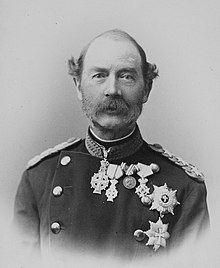
Back Christiaan IX van Denemarke Afrikaans Cristián IX de Dinamarca AN Christian IX Dēna Cyning ANG كريستيان التاسع ملك الدنمارك Arabic كريستيان التاسع ملك الدنمارك ARZ IX Kristian (Danimarka kralı) Azerbaijani دوققوزونجو کریستیان (دانمارک) AZB Крысціян IX Byelorussian Кристиан IX Bulgarian Christian IX Breton
| Christian IX | |
|---|---|
 Christian IX, c. 1900–06 | |
| King of Denmark | |
| Reign | 15 November 1863 – 29 January 1906 |
| Predecessor | Frederick VII |
| Successor | Frederick VIII |
| Duke of Schleswig, Holstein and Lauenburg | |
| Reign | 15 November 1863 – 30 October 1864 |
| Predecessor | Frederick X & II |
| Successor | Lost to Prussia and Austria |
| Born | Prince Christian of Schleswig-Holstein-Sonderburg-Beck 8 April 1818 Gottorf Castle, Schleswig, Duchy of Schleswig |
| Died | 29 January 1906 (aged 87) Amalienborg Palace, Copenhagen, Denmark |
| Burial | 15 February 1906 |
| Spouse | |
| Issue Detail | |
| House | Glücksburg |
| Father | Friedrich Wilhelm, Duke of Schleswig-Holstein-Sonderburg-Glücksburg |
| Mother | Princess Louise Caroline of Hesse-Kassel |
| Religion | Church of Denmark |
| Signature | |
Christian IX (8 April 1818 – 29 January 1906) was King of Denmark from 15 November 1863 until his death in 1906. From 1863 to 1864, he was concurrently Duke of Schleswig, Holstein and Lauenburg.
A younger son of Frederick William, Duke of Schleswig-Holstein-Sonderburg-Glücksburg, Christian grew up in the Duchy of Schleswig as a prince of Schleswig-Holstein-Sonderburg-Glücksburg, a junior branch of the House of Oldenburg which had ruled Denmark since 1448. Although having close family ties to the Danish royal family, he was originally not in the immediate line of succession to the Danish throne. Following the early death of his father in 1831, Christian grew up in Denmark and was educated at the Military Academy of Copenhagen. After unsuccessfully seeking the hand of Queen Victoria of the United Kingdom in marriage, he married his double second cousin, Princess Louise of Hesse-Kassel, in 1842.
In 1852, Christian was chosen as heir presumptive to the Danish throne in light of the expected extinction of the senior line of the House of Oldenburg. Upon the death of King Frederick VII in 1863, Christian (who was Frederick's second cousin and husband of Frederick's paternal first cousin, Louise of Hesse-Kassel) acceded to the throne as the first Danish monarch of the House of Glücksburg.[1]
The beginning of his reign was marked by the Danish defeat in the Second Schleswig War and the subsequent loss of the duchies of Schleswig, Holstein and Lauenburg which made the king immensely unpopular. The following years of his reign were dominated by political disputes, for Denmark had only become a constitutional monarchy in 1849 and the balance of power between the sovereign and parliament was still in dispute. In spite of his initial unpopularity and the many years of political strife, in which the king was in conflict with large parts of the population, his popularity recovered towards the end of his reign, and he became a national icon due to the length of his reign and the high standards of personal morality with which he was identified.
Christian's six children with Louise married into other European royal families, earning him the sobriquet "the father-in-law of Europe". Among his descendants are King Frederik X, King Philippe of Belgium, King Harald V of Norway, Grand Duke Henri of Luxembourg, King Charles III of the United Kingdom, and King Felipe VI of Spain.[2]
- ^ "Schleswig-Holstein-Sonderburg-Glücksburg Royal Family". Monarchies of Europe. Retrieved 15 August 2016.
- ^ "HM King Christian IX of Denmark". European Royal History. Retrieved 15 August 2016.